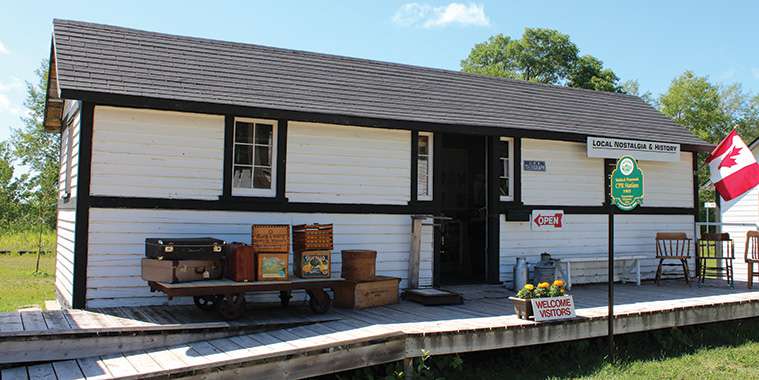By Christian Cassidy
The Village of Dunnottar, (rhymes with daughter), is located 95 kilometres north of Winnipeg off Highway 9 on the west shore of Lake Winnipeg. It is unique among Manitoba’s villages in that it is made up of three distinct communities called Matlock, Whytewold and Ponemah.
Matlock, the oldest of the communities, was a fishing outpost in the late 1880s. Whytewold and Ponemah came about after the CPR created the beach line train to Winnipeg Beach in 1903. While the train brought large-scale tourism to Winnipeg Beach to visit its boardwalk, dance halls, and resort hotels, these three communities to the south avoided such development and became exclusive enclaves for many of Winnipeg’s well-to-do.
Matlock, Ponemah and Whytewold were part of the Rural Municipality of St. Andrews but grew unhappy with the level of service they were receiving. Around 1945, a committee of area cottage owners headed by Winnipeg businessman W. Chandler Birt was formed to explore the possibility of creating a municipality of their own.
An advertisement in the Winnipeg Tribune invited residents to a meeting in the Matlock Community Hall on Saturday, July 20, 1946 “… for the purpose of receiving reports in the matter of incorporation of the Village of Dunnottar and to decide on future action thereon.”
The honour of choosing the name of the proposed municipality fell to retired Winnipeg architect Alex Melville, believed to be the oldest cottager in the communities. It was not surprising that he chose Dunnottar as he was from Fraserburgh, Scotland which is 100 kilometres north of Dunnottar Castle and had already introduced the name to Manitoba.
In 1907, Alex and his brother William established the cottage suburb of Dunnottar Beach at Ponemah. Alex was also a founding member of the Dunnottar Yacht Club and his famed yacht, named Dunnottar of course, won many a Lake Winnipeg regatta in the early 1900s.
At the conclusion of the meeting, residents chose to proceed with plans to secede from St. Andrews and petition the Manitoba Legislature. In June 1947, the legislature passed an order-in-council establishing the Village of Dunnottar effective January 1, 1948. It was in good company as other communities that attained village status in 1948 include Cartwright, Crystal City, Macgregor, St. Pierre, Lac du Bonnet and Treherne.
The first municipal election for the Village of Dunnottar was held in November 1947. Nominations took place in a downtown Winnipeg office under the supervision of businessman and new municipal secretary James Coutts.
The council was made up of four councillors and a mayor, all of whom were acclaimed. They were: D. F. Reid of Ponemah, James H. Finlay of Whytewold and Frank W. Frogley of Matlock. Joseph Chapel of Matlock was the only permanent resident of the municipality to be acclaimed and he held the seat set aside to represent his fellow permanent residents.
The first mayor of the Village of Dunnottar was Albert J. Smale. At the time he was vice president and sales manager at Donald H Bain Ltd., a Winnipeg-based wholesale grocery business with offices stretching from Montreal to Vancouver. He resided in Tuxedo and had a cottage at Whytewold.
The inaugural meeting of the Village of Dunnottar council took place on January 6, 1948 in the T. W. Taylor Building at 177 McDermot Avenue in Winnipeg.
Balancing the needs of its permanent residents against its summer-only residents has always been a tightrope walk for the village council. The number of permanent residents in the early 1950s was around 200 with a summer population of about 800 more. That number remained steady into the 1970s. In recent years, Dunnottar’s permanent population has grown from just under 500 in 2001 to over 750 in 2016. Its summer population is now estimated to be around 3,000.
The Village of Dunnottar has continued to shun large-scale development in favour of retaining a traditional cottage community lifestyle.
Dunnottar has three public beaches: Bowling Green Park; Tugela Creek Park; and Milne Park where you will find the community’s iconic piers. These wooden structures, there are usually eight of them, bring swimmers out to deeper waters and in the evenings are a gathering spot to watch the stars from. They are constructed each spring and removed at the end of the summer.
Other public spaces include a small park on Gimli Road featuring an artesian well and a cairn celebrating area resident and multiple world championship rower Colleen Miller. Milne Park at Matlock Beach features a garden with a seating area and a cairn dedicated to William Milne, a former municipal councillor and operator of the Matlock General Store who died in 1987.
A must-see for any visitor to the area is the seasonal Dunnottar Station Museum which is housed in the former Matlock train station. In 2005, a group of community volunteers purchased the station, moved it to its present site on Central Avenue at Railway Street in Ponemah, and restored it to its former glory.
Though the building measures just 10 metres by 3 metres, it is packed with photos, maps and other memorabilia that tells the story of the Village of Dunnottar and its three beach communities.
Christian writes about local history on his blog, West End Dumplings.



